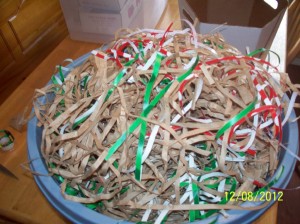I hate to be so bahumbug about one of my and most people’s favorite holiday, but it’s a fact. Christmas is the most wasteful holiday.
According to recycleworks.org, from thanksgiving to new years’, our household waste increases by more than 25 percent. With everything from added food waste, to wrapping, packaging, it adds up to over 1 million tons a week going into a landfill.
Half the paper used in America is used to wrap products. And the 2.65 billion Christmas cards sold in America (so this doesn’t include the cards not sold that are thrown away) could fill a football field for up to 10 stories.
If everyone reused just two feet of holiday ribbon, it would add up to enough to tie a bow around the planet. How’s that for a Christmas present to us and the Earth?
Food waste is also one of the biggest waste contributors. Food waste makes up to a quarter of the garbage thrown away during Thanksgiving and New Year’s. A household of four could save an average $100-$125 by reducing food waste.
The good news is that both of these problems have solutions.
To address our overconsumption of paper:
- Save wrapping paper this year to use for next year. It takes a bit of effort and patience from everyone involved because everyone has to wait while you carefully unwrap your presents.
- Use recycled paper products. Recycled cards, wrapping paper, bags, etc. And you could always send an e-card, instead of paper. If everyone sent one less card we could save 50,000 cubic yards of paper.
- Use alternatives to the conventional wrapping paper. Newspapers, reusable bags (which is a gift in itself and it keeps on giving), use bags or used boxes, paper bags from the store, fabric, (fabric is harder to rip to shred, which makes it easier to reuse) jars or cans (mixes are adorable in jars), I will also tell you, unashamedly, that part of my parents gifts were wrapped in Pringle’s cans. Let your creativity run wild and feel no shame.
- Upcycle your paper. Most of these things are super easy. Gifts bags made from newspaper or wrapping paper, bows made from any kind of paper, paper confetti (we used brown packing paper and some used wrapping paper that wasn’t in such good shape and shredded with a paper shredder).
And for our waste of food? Mostly it has to do with planning ahead. Planning portion sizes, what people tend to eat more or less of, how you plan to store it, etc.
- This site, love food, hate waste, is site teaching about food waste and how to cut down. The statistics are based from the UK, but the principles can be applied anywhere. It helps with planning portion, storing and recipes so you can use the same ingredients in a different recipe.
- You can also donate it. I feel a little iffy about this sometimes, but if you can find a homeless shelter who will take unpackaged food then why not?
- Have a potluck. Everyone bring a dish and take home the leftovers.
- Embrace the leftovers. I’m not a big fan of leftovers, but some things like pie can never be eaten too many times. I try to just think of everything as leftover pie.
- Compost your plain, raw fruits and veggies.
The main thing is to be aware of the waste and take it into a count when planning your holiday festivities. Feel free to leave a comment on how you plan to cut down waste during the holiday season.

